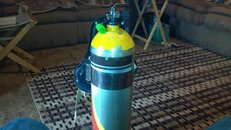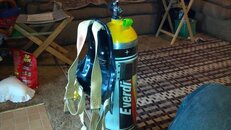Do you use slightly more air if you have to inhale more to control the buoyancy?
There is a lot more to it than that.
Breathing depth does come into play but it's more about breathing cadence and how full your lungs are at any given time. An average adult male has somewhere between 10 and 15 lbs of lift between fully deflated and inflated lungs or a more useful way of looking at it, around 5 to 7 lbs of swing above and below mid breath, in no BC diving you learn to take advantage of this. Early in the dive, you tend to "breath off the top of your lungs" which means you do not exhale quite as deeply as normal and at the same time inhale slightly more than "normal" on the inhale. This is not excessive amount, if you are properly weighted you are only around 2 lbs overweighed at the beginning of the dive. No more gas is used, just the average point of lung inflation changes. At the same time you change the cadence of your breathing, you inhale longer and slower and exhale quicker and shallower which will give you an overall bit of positive buoyancy. Average lung inflation and cadence combine to give you the slight amount of positive buoyancy you need at the beginning of the dive to compensate for the slight excess weight you have one. How much you vary the 2 give you control for accents and descents, going over a coral head for example. As the dive progresses your breathing slowly shifts to a normal rhythm and closer to the end of the dive it will shift to a lower average inflation of your lungs with longer slower exhales followed by shorter, quicker inhales, that gives you the slight negative overall buoyancy you need. This may sound like a lot but in reality, once you become use to it, it’s pretty much automatic. I compare it to learning to drive a stick shift car. At first you have to think about how much to let out the clutch and how much gas to give it but after doing it a while, it becomes natural and you don’t think about it, it becomes more feel than thought. As for overall air consumption, mine goes way down. I am not dragging along a flapping wing that creates drag, nor am I hauling around excess weight I have to move.
Last edited:






